
|
 |

|
 |
Of interpretations, Indic thoughts and dance dilemmas: A tale of twin cities - Dr. Sujatha Maringanti e-mail: sujathamaringanti@gmail.com October 14, 2018 As a keen observer of the cultural scene for well over a decade, I attempt to make sense out of a cultural phase that my city is going through. Let me conjure up a magic carpet and take the readers along. Land: As the landscape of Hyderabad (the capital city of erstwhile combined state of Andhra Pradesh and currently divided state of Telangana) is changing by the minute to embrace modernity, the city continues to remain steeped in history, antiquity, quaint customs and rituals. If we peer beyond the tourist rhetoric such as 'The City of Pearls, Dum Biryani and monuments,' Hyderabad is an interesting cultural space with a diverse mix of people and languages. A walled city once upon a time, Hyderabad has historical treasures within its confines not just in the form of mosques and minarets but in its artisans, languages, music and dance. Its twin city Secunderabad bears more evidences of its colonial past in its cantonments, churches with attached convent schools and in its heterogeneity of people who served and settled here after their service in British Cantonments as well as in Nizam's military forces.The geographical location of Hyderabad translates to a relatively safe environment and with the added incentive of being a major Pharmaceutical and IT hub, it continues to attract a steady stream of migrants, primarily from Northern states, adding to the already existing cosmopolitan mix of various religious, social, cultural andeconomic backgrounds. 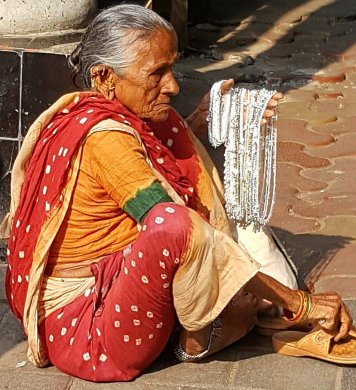 The face of Hyderabad Hyderabad is a land of spectacular contrasts! If the last Nizam ruler, Mir Osman Ali Khan Asaf JahVII ranked fifth on the Forbes list of 'All Time Wealthiest,' the poorest of poor live in the by lanes of Charminar, eking out their livelihood from practicing small trades that their families have been engaged in for several generations, such as the lac bangles that Hyderabad is so famous for. Old city is a place where among other things, the ever-so elusive attar (perfume) making people lived, some of whom were significant contributors to the making of mitti attar (petrichor or scent of raindrops falling on dry soil). Contrasting this, the heart of the city boasts the shimmering "Heart of the world" (Hussain Sagar), the world's largest artificial lake in heart shape, once a source for drinking water, and now reeking from pollution. The high rises of the Hitech city, malls and fancy resorts serve as evidences for the topical paint of modernity the city has adorned. If we dig deeper, literally and metaphorically, this land reveals that its surroundings have been the sites where Buddhism flourished between the 1st century and 4th century BCE. As the magic carpet is gliding past the old city, a discerning observer would see the effortless rhythm of the city in the Muslim prayer call (azaan), and in the laid- back attitude of people moving in and around the old city attending to their businesses and daily chores. A lilting Kishore Kumar song from a radio competes with a racy new number from Bollywood on television, only to be drowned in the loud Teen Maar dance on the street which accompanies the first Bonalu (offering to Goddess Kali) to the temple in Golconda fort, the special touch being that the Teen Maar (Maarfa) was introduced to Hyderabad by African Siddi community. As the magic carpet continues to zoom past the heart of the city, innumerable mansions, gardens and palaces of Nizams, some of them donated for universities and libraries, stand tall with pride, having witnessed game-changing debates and discussions. All India Radio station, the internet of yesteryears, serves as a beacon of knowledge with several generations growing up listening and relying on its quality educational programs and music. Hyderabad was and continues to be home to powerful writers, intellectuals, fabulous lyricists, scholars, architects, singers, poets, dancers and creative people from theatre and film fraternity. Not to mention the rebels with and without a clue! Mushayiras (an evening of Urdu poetry) and Kavitha sammelanams (Telugu and Hindi poetry recitations), theatre and music from national and international bands-Hyderabad has it all! Last but not least, one can also enjoy the rustic flavour of various folk-art forms that were prevalent in the Telugu states once, which form the most fundamental and dynamic linkin understanding a certain culture, since they mirror the cultural evolution of the land. They sing the story of the land! As a newly minted state, Telangana is trying to forge association with and reach out to re- establish itself with an identity of its own on all fronts- economic, political and cultural-drawing its strength from its past. As a part of its cultural promotion, various workshops, seminars, conclaves and a host of cultural activities are being organized in various cultural centres of the city. Recently concluded, Nartanam conclave, thanks to the tireless efforts of Madhavi Puranam of Nartanam dance journal, had many discussions and debates on dance related issues along with beautiful dance performances. Let us now pause our magic carpet and hover over the city's iconic cultural centre, Ravindra Bharathi, where arangetrams (debuts) take place at lightning speed with young dancers dancingto their social media followers and thanking the journalists for gracing the occasion, who faithfully write glowing reviews the next morning! Make no mistake, their technique is adequate to wonderful, depending on their teachers and they essay lengthy varnams, padams and javalis and they mimic their 'gurus' to the T, a joyful evidence that many are imparting and many more are imbibing classical culture! However, scratch beneath the surface - beyond these joyful renderings of padams, glittering jewelry and costumes - one can perceive that there is a certain disconnect and a hollowness that provokes unsettling questions. Questions that are never asked or addressed in any workshops or conclaves, the proverbial elephant in the room! The questions are related to but not limited to the dancer's understanding of (or rather, lack of) the content, context, body awareness teaching and research methodology and the adequacy of the training that is being imparted to these youngsters. People: Let us navigate our magic carpet now to take a look at the people that inhabit these cultural spaces. If "it takes a village to raise a child," it takes a community to raise an artist, for both are similar processes where concerted effort of various people from the community is essential for healthy and overall development.The interplay and the collaboration of four principal elements - the patrons, the performers, the peer reviewers and the audience - is crucial for the growth of the art and the artist. If we fly over the past few centuries on our magic carpet, we can clearly see evidences for existence of such robust cultural ecosystems, tightly associated with the temples, nurturing the artists and art forms. It will be a remiss on my part, if I do not emphasize the role of Ganika or in modern parlance, Devadasi, in this cultural ecosystem. Devadasis donned the role of the performer, while the kings donned that of the patrons and the scholars and experts played the roles of reviewers. And since the content of the performance was meaningful in the given social context, there was no dearth of the audience! The patronage was centralized and the roles were very clear. Contrary to many perceptions, Devadasi was considered as a pride of the king's court because of her scholarship and her artistry. She played a pivotal role in initiating and mobilizing social changes and her role was not relegated to mere entertainment and in carnal pleasures as it was perceived by many "modern" thinkers. She had complex intellectual roles to play, one of which was to use the narrative (i.e. stories) to transiently disconnect from the mundane and shift the gaze of the king and the society towards intellectual and spiritual matters. Other important role that Devadasi played was that of a reviewer of the conduct of the society and the king. There is a framework of moral and ethical conduct of the king that was of paramount significance for the survival of the tribe and the Devadasi's social responsibility was the upkeep of that integrity and framework. Devadasi was a scholar, proficient in at least two languages, one of them being Sanskrit, and was well versed in several arts, which include but not limited to literature, dance and music. She was well aware of and informed about the political and societal conditions. She was a link between the secular and spiritual planes. To this end, the stories were chosen and presented at three different platforms; one in front of the local deity, one in the court in the presence of the king and the scholars and one in front of the common people. Devadasis were given the finances and the space and they never had to function as a part of the rigid familial structure and duties. Their time and intellect were dedicated to acquiring and perfecting the art and using it for social good. Hope it does not count as a digression, if I point here in the direction of Virginia Wolff's 'A room of one's own'. Devadasi shines brilliantly from the history pages, as an independent, free-spirited individual with bright intellect, who used dance and music as her medium of expression. This was, of course, up until she lost it all with the loss of the royal patronage. The tightly knit cultural ecosystem fed into and drew out of a spring well of knowledge comprising of a complex matrix of collective cultural memories.This knowledge system was handed down mostly by oral tradition with a few exceptions of well- documented knowledge in the form of texts. All of the sub-continent's arts nestled in this fountain head of knowledge, which emphasized the enquiry, thought and the continuity rather than freeze fixing on one set of societal conditions or markers. In any land, subjected to multiple invasions and faced with uncertainties, there evolves a way to safeguard its intangible assets such as arts and culture and pass it on to the later generations as cultural memory. The brilliance of this knowledge system lies primarily in its applicability to any set of parameters of time and space. Devadasis, therefore, were the store houses of cultural memories of performing arts. Now returning to our times, rebuilding of such communities in modern context is essential with all four elements; patrons, performers, peer reviewers and the audience, in an interconnected manner. This interlinking is essential for the younger generation to be able to understand the context and dip into the fountain head of knowledge that we possessed earlier and to understand the texture of the cultural fabric which got tattered during and after the Colonial times. In any system, a society, institution or an organization, a few individuals always remain at the core and act as the driving force behind change - a micro change - perhaps, but change all the same. The significance of such work often goes unnoticed and unheard in the din of loud and glittering shows and media coverage with no content or worse yet, gets written as reports with very superficial analysis of the content or the intent of the presenter. The ability and the innate need of a few individuals, from any sphere of the society, to connect and to create learning spaces and the ambience for the younger generations and serve as catalysts for change, forms the core of this review. Progress and growth, not just in art but in any area, happens with such intent. It is the same intent that drove Nataraja Ramakrishna, the dance doyen from yesteryears, to approach C.Anjaneya Reddy, an IPS officer and an avid art supporter to help turn an abandoned monument like Taramati Baradari into an exquisite venue for cultural events. It is the same intent of Kiran Seth, an IIT professor, that resulted in the genesis of SPIC MACAY. It is the same intent which made Rukmini Devi to put together a dance form which is now known as Bharatanatyam and it is the same intent that drove Balasaraswathi to strive to keep the essence of the traditional art of Devadasis from getting diluted or put into strait jacket. With all their differences in stance, pun intended, Balasaraswathi and Rukmini Devi have carved specific cultural niches within their capacity. There are n number of other individuals who voluntarily take up the role of patrons and majority of them,which include family members, friends, teachers, colleagues and sometimes even the audience, remain invisible and often their contribution towards the journey of the art and the artists goes unacknowledged. We can't google these names and their faces do not smile from the glossy pages of magazines and journals. The bodies which belong to these names are often busy either making sambar for lunch or tending to vegetable patches in the backyard or selling insurance policies or being a real estate agent! Some may even be making garlands outside the temple in which the concerts are happening or they may be running a phone booth! The common thing that all these bodies have is the intent in their mind to contribute towards something of bigger purpose. The intent to shift the gaze of their own as well of those they come in contact with - from mundane to that of something special. No government funding or the accolade gives the artists the immense satisfaction that the gleam in the eye or the blessings such patrons bestow upon them. Just goes to show that life and art happen in small pockets of spaces and in unknown, narrow by-lanes, driven by obscure forces. 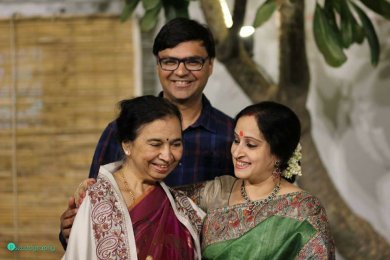 Anupama Kylash with her aunt 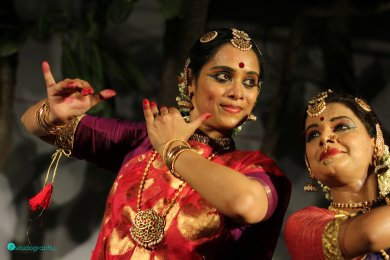 Vamsi Madhavi & Pujitha The present review highlights the work of two dance scholars; Anupama Kylash and Jayachandran Surendran from Hyderabad, whose performances and presentations are often work in progress and delineate a dot to dot progression with enquiry at heart and an intent to share their experiences of dance with younger dancers, fueling the thought process further. Anupama is a faculty at Silicon Andhra University, California, and a senior performer, teacher, choreographer with several performances and lecture demonstrations to her credit in India and abroad. Jayachandran Surendran is a senior dance research scholar at IIIT, Hyderabad, with close to a decade of experience in research and documentation in Kalakshetra, a premier dance institution in South India. Pushing the envelope diligently and working within the traditional framework, these two scholars have been exploring the complex and most comprehensive South Indian dance and are trying to identify the common thread running between various art forms. I am reviewing the gist of some of their work, as I connect my dots as I perceive them and the overall dance scenario in Hyderabad. I have picked the following three pieces of their work which showcases not just their intent to bring research and methodology into the dance forms but also their sensibilities as artists and as sensitive human beings with an intent to bridge gaps and to connect to the younger practitioners. In her third Ramachar Memorial Concert, Anupama Kylash highlighted and acknowledged the services and commitment of her late uncle, B. Ananda, an insurance company employee and a tennis player, towards arts, by felicitating his wife. It is her way of acknowledging the contribution of the art enthusiasts and supporters who remain as the backbone for any education that takes place in a society. Dance in India existed as a component of a complex matrix of interconnected knowledge built with a wonderful scope for myriad interpretations. The division of the corpus of dance based on states and communities is a relatively new trend. With this premise, Anupama Kylash examined South Indian dance forms; Kuchipudi, Bharatanatyam and Vilasini Natyam by comparing and contrasting the component items such as Shabdam, Swarajathi, Shabda Pallavi and Tarangam. Vamsi Madhavi, a Kalakshetra graduate with extensive training in Bharatanatyam and Kuchipudi and Pujita Krishna Jyoti with a strong background in Kuchipudi and a brief exposure to modern dance, jazz and salsa, were the performers of the evening. Both the dancers are well versed in their style and are currently training under Anupama in Vilasini Natyam. Anupama's care and discretion in choosing the items to present is evident in the ample scope the pieces had to showcase, not just in the subtle differences in the nritta (pure technique) and abhinaya (expression), but also in the myriad interpretations. Weaning away from the routine "butter eating Krishna", Anupama weaved an innovative interpretation to the lyrics of Tarangam Nanda Nandana Gopala, to bring out the philosophical context in the piece. She highlighted the contrasting texture by showcasing a few of his leelas; the same Krishna who bent low for friend Sudhama, elevated for his friend Arjuna, stole the vastras of gopikas but gave the same to Draupadi. The pure abhinaya pieces, a very special and poetic aspect of Southern dance aesthetics which deal with love, relationships and life experiences, depicted the state of mind and moods of various Nayikas. While Vamsi Madhavi portrayed her Nayika with controlled and graceful movements of Kalakshetra bani, Pujitha's nonchalant attitude particularly suited the Nayika she portrayed. The next work, The Thinking Cap Series, spearheaded by Anupama, is an attempt to rekindle the interest in research in matters related to performing arts, with an emphasis on promoting an environment of informed learning. The series kick started with the showcasing of analytical skills and thought process of the dance scholar Jayachandran Surendran. His talk on Thiruvarur, a celebrated temple town in Tamilnadu, as interpreted in the varnam 'Roopamu Joochi' raised the curtain on discussions on Indic thought and wisdom, which is the lifeline for Indian aesthetics, philosophy and art. His brilliant analysis pointed in the direction of a need for deeper contemplation when deciphering the layered and coded language of Indic wisdom and on how a work can be choreographed to not just present the linear narrative but to develop the narrative further to bridge the gap between the narrative and the metanarrative. Seekathon is the most recent event, which was organized by a passionate dancer, Pramod Kumar Reddy (Abhinetri Arts Academy) with the enthusiastic support from Mamidi Harikrishna, director of Department of Language and Culture, Telangana State. Text reading in dance is the topic on which Jayachandran had elaborated while Anupama talked about the interpretation of literature through abhinaya. 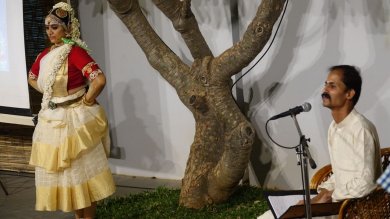 Jayachandran & Vamsi Madhavi 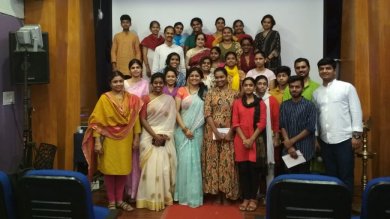 Seekathon The research and the debates should not remain in the journals collecting dust in the university libraries or restricted to conclaves and intimidating scholarly environments but should take place in environments where the students feel free to question what they do not comprehend and put forward their ideas without the pressure of judgment from any corner. Clearly, both Anupama and Jayachandran are striving to create such learning spaces, the right tools and ambience to empower themselves and the next generation in dance studies. The gaps and the dancing dilemmas: As Kapila Vatsyayan aptly described, Indian dance forms are contextual in nature. They were part of comprehensive knowledge systems which were transferred from one generation to the next along with a lot of interconnected subsets of knowledge. For example, Devadasis functioned solely from their complex abilities and sophisticated knowledge which came with their inherited "genetic memory". In other words, the art being with them for generations enabled the Devadasis to function from their genetic memory. The inherent problem with this is that the dancers who are from outside the community are at a disadvantage with respect to the methodologies required to teach and/or choreograph new work. Most of them had acquired the products of the teaching in the form of items but in order to build something new, the dancers have to dwell deep into what they learnt and push the boundaries to create something new. This is a daunting task for many, who are otherwise strong dancers, who shy away from choreographing new work and instead stick to repeating the same pieces ad nauseum. As a community of people who are interested in arts, be it as performers, critics, patrons or audience, we need to go beyond "large attractive eyes, brilliant music, colourful costumes and fabulous lighting" rhetoric and move consciously away from thec omfort zones of repeating, rehashing and recycling the old pieces of work. Critical reviewing of every piece of work is an essential parameter in advancing any artform. Performance is communication. We tell stories using our bodies. If the dancer is not sure about what she is communicating, then it becomes just a movement - pretty at the best and meaningless at the worst! Performing a complete margam, requires conviction on the part of the dancer. She/he may have the perfect angashudhi and the deepest aramandi but if they are not convinced of what they are dancing to, it is a meaningless exercise.When the voice of the dancer is not expressed through his/her artistry, the movement becomes mere mimicry. Every dancer has to embark on her/his inner journey at a certain point. The role of the tradition and the teacher is to bring the student to a place, a boundary so to speak, where the contemplation begins. But in majority of the cases, the training is incomplete with respect to many aspects. Senior dancers who are evolved with respect to their own artistry have a major role in showing the path to young dancers and in probing them to research and to grow. This research needs to penetrate not just into one's own aesthetics but also into understanding of their own sexuality. It is pointless to throw explanations such as "love depicted in varnams and padams is a representation of Jeevatma-Paramatma union", at students with abysmal lack of understanding of such content and the context. In a society where the word sex is not uttered without much discomfort, where youngsters and adults alike are inadequately informed or rather grossly misinformed about issues related to sexuality, it is too much to expect a sixteen-year old dancer, solely trained in movement, to reach the maturity to understand the spirituality behind pieces which are part of highly evolved literary and philosophical contexts. Senior dancers' role in contemplating on such issues and coming up with ways to bridge the gaps is immense. Now that a grand tour of Hyderabad is finished, we can alight from the magic carpet and let the "elephant in the room" do the rest of the speaking! Before we arm-twist government officials and corporates on funding "culture", which we should gladly do, why not take a serious look at what kind of culture we are disseminating? The answers to most of the questions do not lie in mere lack of funding. It has to do with the lack of intent on the part of the members of the community to push in the right direction. What is the basis for associating culture with only "classical" dances? Why are the vibrant folk dances, now mostly relegated to villages and on the verge of extinction, not adopted and incorporated into the cultural matrix to tell our stories- past, present and future? How is it that languages, which are windows to culture and which are so vital to understanding the context and meaning of any work so neglected in education? Who will articulate to the "look at me" generation that dance is a living, breathing medium which can be utilized to tell a story, a contemporary story, without all the bells and whistles? When do we get to see a young dancer who uses her training, body, mind and "voice" to tell a story that makes sense to everyone in the audience? Why are the talks about emotional intelligence, dance and art appreciation not reaching a stressed-out engineering student who is contemplating suicide because of the excessive academic pressures? How is it that there is no connection between what is going on around us and what we are depicting in the dance? Why aren't the doors of Ravindra Bharathi being thrown open for classical dance and art appreciation to school and college children once every month with senior dancers presenting the material in a manner in which the connections are made by youngsters? Why are we constantly updating our apps and phones but not the context of the most beautiful and powerful communication medium that we have - our dance? If only I have a magic genie to bring that intent in the community to work in collaboration and bring back the meaningful art that this subcontinent enjoyed for centuries! Dr. Sujatha Maringanti is a scientist and a lawyer based in Hyderabad. She has a certificate in Bharatanatyam from Bhaktha Ramadas College for Music and Dance in Hyderabad. She runs a voluntary organization called Art Can Happen Anywhere (ACHA) through which she organizes sessions on theater and art in general and works with school children to connect with the youngsters. Comments * The thoughts presented in the article are the "need of the hour" in the cultural scene of India. The questions raised are very significant and need contemplation by all the concerned or all the stake holders of 'Art', 'Culture' and 'Art Forms' across India. The 'story-like' article using a symbolic magic carpet to touch all things and times that are relevant to the narrative is particularly impressive! - Srinivas Chilakamarri (Nov 7, 2018) Post your comments Please provide your name and email id when you use the Anonymous profile in the blog to post a comment. All appropriate comments posted with name & email id in the blog will also be featured in the site. |